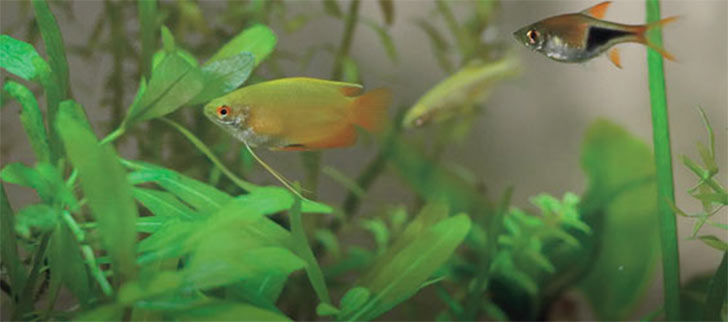
It is imperative that you have an understanding of the water parameters that affect fish health, as well as the importance of water testing. Water testing cues you to what's happening in the system at any given time, helping you diagnose potential problems so you can take corrective measures immediately.
Every fish hobbyist should own a decent water testing kit. Besides water temperature, some of the basic parameters that require testing on a regular basis are ammonia, nitrite, nitrate, pH, and specific gravity. Maintaining proper range in each of these parameters is vital to the health and longevity of your fish. You should also chart your results in a written log. This will help you identify what factors may be contributing to the undesirable results.
Ammonia is the most toxic nitrogenous compound in the aquarium. It is a by product of fish respiration, excretion, and also comes from decaying foods in the aquarium. Nitrite is also toxic. In the breakdown of organic wastes, it occurs as a midpoint in the nitrogen cycle between ammonia and nitrate. Nitrate is the least toxic end product of the breakdown of organic wastes, but high levels can produce algae blooms.
Keeping pH, temperature, and specific gravity stable helps prevent stress to your fish. Stress due to fluctuating water conditions is one of the main causes of fish illness and death. The chart below is a good reference to find acceptable ranges for the most vital water testing parameters. It also includes hints on what you can do if your results fall outside of the acceptable range.
| Test |
Acceptable Range:
Freshwater |
Acceptable Range:
Saltwater (Fish Only) |
Acceptable Range:
Brackish |
Test Frequency |
Remedies |
Ammonia
(NH3) |
0.00 ppm |
0.00 ppm |
0.00 ppm |
Daily when cycling; weekly after established |
Partial water change, Reduce feeding, add a bacterial additive like
Stress Zyme or an ammonia removing product like
AmQuel. |
| Nitrite |
< 1.0 ppm (Ideally 0.00 ppm) |
0.00- 0.04 ppm (Ideally 0.00 ppm) |
0.00- 0.04 ppm (Ideally 0.00 ppm) |
Daily when cycling; once every 2-3 weeks after established |
Partial water change; Reduce feeding, add a bacterial additive like Nitromax. |
| Nitrate |
< 60 ppm |
< 50 ppm |
< 50 ppm |
Once weekly |
Partial water change; add
live plants. |
| pH |
6.0 -7.8 |
8.0 - 8.4 |
7.2 - 8.3 |
Several times weekly |
Use a pH buffer for freshwater, a marine buffer, for saltwater, or Proper pH 8.2 for brackish systems. |
| Temperature |
75° - 80°F |
75° - 80°F |
75° - 82°F |
Daily |
Adjust heater; you may need to add a chiller in saltwater systems if lighting gets water too hot. |
| Specific Gravity |
1.000 - 1.001 |
1.022 - 1.025 |
1.006 - 1.015 |
Weekly |
Premix saltwater with slightly more salt if specific gravity too low; less salt if too high. Then, do a partial water change with your adjusted mix and test again. |
|